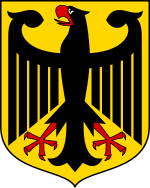Henry the Fowler

Henry I the Fowler (German: Heinrich der Finkler or Heinrich der Vogler; Latin: Henricius Auceps) (876 – 2 July 936) was the duke of Saxony from 912 and king of the Germans from 919 until his death. First of the Ottonian Dynasty of German kings and emperors, he is generally considered to be the founder and first king of the medieval German state, known until then as East Francia. An avid hunter, he obtained the epithet "the Fowler"[1] because he was allegedly fixing his birding nets when messengers arrived to inform him that he was to be king.
Contents |
Family
Born in Memleben, in what is now Saxony-Anhalt, Henry was the son of Otto the Illustrious, duke of Saxony, and his wife Hedwiga, daughter of Henry of Franconia and Ingeltrude and a great-great-granddaughter of Charlemagne. In 906 he married Hatheburg, daughter of the Saxon count Erwin, but divorced her in 909, after she had given birth to his son Thankmar. Later that year he married St Matilda of Ringelheim, daughter of Dietrich, count in Westphalia. St Matilda bore him one son called Otto and two daughters, Hedwige and Gerberga and founded many religious institutions, including the abbey of Quedlinburg where Henry is buried, and was later canonized.
Succession
Henry became duke of Saxony upon his father's death in 912. An able ruler, he continued to strengthen Saxony, frequently in conflict with his neighbors to the South, the dukes of Franconia.
In 918 Conrad I, king of the East-Francian Empire and duke of Franconia, died. Although they had been at odds with each other from 912–15 over the title to lands in Thuringia, before he died Conrad had recommended Henry as his successor and king. Conrad's choice was conveyed by Duke Eberhard of Franconia, Conrad's brother and heir, at the Reichstag of Fritzlar in 919. The assembled Franconian and Saxon nobles duly elected Henry to be king. Henry refused to be anointed by a high church official — the only king of his time not to undergo that rite — allegedly because he did not wish to be king by the church's but by the people's acclaim. Duke Burchard II of Swabia soon swore fealty to the new king, but duke Arnulf of Bavaria did not submit until Henry invaded Bavaria in 921.
Policy
Henry regarded the kingdom as a confederation of stem duchies rather than as a feudal kingdom and saw himself as primus inter pares. Instead of seeking to administer the empire through counts, as Charlemagne had done and as his successors had attempted, Henry allowed the dukes of Franconia, Swabia and Bavaria to maintain complete internal control of their holdings. In 925 he defeated Giselbert, duke of Lotharingia (Lorraine), and brought that realm, which had been lost in 910, back into the German kingdom as the fifth stem duchy (the others being Saxony, Franconia, Swabia, and Bavaria). Allowing Giselbert to remain in power as duke of Lotharingia, Henry arranged the marriage of his daughter Gerberga of Saxony to his new vassal in 928.
Henry was an able military leader. In 924 he paid a tribute to the Magyars (Hungarians), who had repeatedly raided Germany, and thereby secured a ten-year truce so that he could fortify towns and train a new elite cavalry force. During the truce with the Magyars, Henry conquered the Havelli and the Daleminzi in 928 and put down a rebellion in Bohemia in 929. When the Magyars began raiding again, he led an army of all German tribes to victory at the battle of Riade in 933 near the river Unstrut, stopping their advance into Germany. He also pacified territories to the north, where the Danes had harried the Frisians by sea. The monk and historian Widukind of Corvey in his Res gestae Saxonicae reports that the Danes were subjects of Henry the Fowler. Henry incorporated into his kingdom territories held by the Wends, who together with the Danes had attacked Germany, and also conquered Schleswig in 934.
Death and aftermath
Henry died of a cerebral stroke on 2 July 936 in his palatium in Memleben, one of his favourite places. By then all German tribes were united in a single kingdom. Henry I is therefore considered the first German king and the founder of the eventual Holy Roman Empire. He has sometimes been considered as Henry I, Holy Roman Emperor.
His son Otto succeeded him as Emperor. His second son, Henry, became duke of Bavaria. A third son, Brun (or Bruno), became archbishop of Cologne. His son from his first marriage, Thankmar, rebelled against his half-brother Otto and was killed in battle in 936. After the death of her husband Duke Giselbert of Lotharingia, Henry's daughter Gerberga of Saxony married King Louis IV of France. His youngest daughter, Hedwige of Saxony, married Duke Hugh the Great of France and was the mother of Hugh Capet, the first Capetian king of France.
Henry returned to public attention as a character in Richard Wagner's opera, Lohengrin (1850). There are indications that Heinrich Himmler imagined himself the reincarnation of the first king of Germany.[2]
See also
- Kings of Germany family tree. He was related to every other king of Germany.
Notes
|
Henry the Fowler
Liudolfing
Born: 876 Died: 2 July 936 |
||
| Regnal titles | ||
|---|---|---|
| Preceded by Conrad I |
King of the Germans Challenged by Anti-King Arnulf the Bad 919-921 23 April 919 – 2 July 936 |
Succeeded by Otto I, Holy Roman Emperor |
| Preceded by Otto the Illustrious |
Duke of Saxony 30 November 912 – 2 July 936 |
|
|
||||||||||||||||||||||||||||
